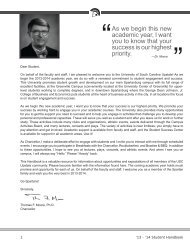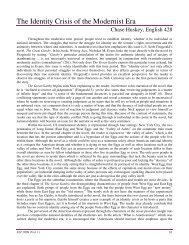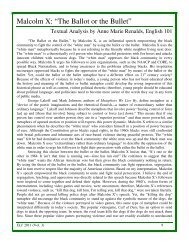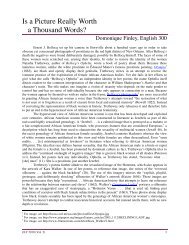The Andy Warhol Photographic - University of South Carolina Upstate
The Andy Warhol Photographic - University of South Carolina Upstate
The Andy Warhol Photographic - University of South Carolina Upstate
You also want an ePaper? Increase the reach of your titles
YUMPU automatically turns print PDFs into web optimized ePapers that Google loves.
photographs tell us about one <strong>of</strong> the greatest artists <strong>of</strong> the 20th century, and what do they<br />
have to say to each other In contrast to the relative conceptual clarity and visual uniformity<br />
<strong>of</strong> <strong>Warhol</strong>’s Pop Art silkscreen paintings <strong>of</strong> soup cans and movie stars or the avant-garde<br />
stillness <strong>of</strong> his experimental film work, the vast and varied corpus <strong>of</strong> <strong>Warhol</strong>’s photographs<br />
seem at once too messy, too heterogeneous, and, to a certain extent, too inconsequential to<br />
be fully comprehensible. Indeed, despite the extensive body <strong>of</strong> critical and scholarly work on<br />
the artist and his work, <strong>Warhol</strong>’s photography has, with a few notable exceptions, been given<br />
relatively short shrift. 2<br />
This is perhaps because <strong>Warhol</strong>’s photographs are not only large in number, they also<br />
pose certain challenges to established notions <strong>of</strong> fine art photography. Photography has never<br />
been an easy fit within the art historical canon. Despite the embrace <strong>of</strong> art photography in<br />
museums and galleries over the past 40 years, the medium’s technological simplicity, its indexical<br />
relation to the physical world, and its mass culture appeal have historically been at odds<br />
with the modernist history <strong>of</strong> art as an expressive, creative, high-cultural form. Indeed, as<br />
Christopher Phillips points out in his history <strong>of</strong> the Museum <strong>of</strong> Modern Art’s vanguard department<br />
<strong>of</strong> photography (the first in an American art museum), even the MoMA was not able to<br />
exhibit fine art photography with any real success until the 1960s. 3 Thus <strong>Warhol</strong>’s photographs<br />
were made in a period when photography itself was still something <strong>of</strong> a fledgling art medium.<br />
Moreover, <strong>Warhol</strong>’s particular style <strong>of</strong> photography did little to mitigate the issue <strong>of</strong> photography’s<br />
debatable status as art. <strong>Warhol</strong>’s deliberately deskilled approach to all art making is<br />
particularly in evidence in his photographs. <strong>Warhol</strong> liked his cameras idiot-pro<strong>of</strong> and used<br />
only the most vernacular and limiting <strong>of</strong> photographic technologies. <strong>Warhol</strong> also took what,<br />
by most aesthetic standards (<strong>of</strong> his day or ours), would be considered “bad photographs,”<br />
refusing any kind <strong>of</strong> technical mastery <strong>of</strong> lighting, framing, focus, or depth <strong>of</strong> field. Instead, he<br />
favored an approach—one hesitates to call it an aesthetic, even in the raw, unstudied mode <strong>of</strong><br />
photographers like Larry Clark or Nan Goldin—that conveys banality more than anything else.<br />
And if art photographers <strong>of</strong> the day sought to distance themselves from photography’s<br />
2 <strong>The</strong> key exceptions are William Ganis’ singular monograph on the subject, <strong>Andy</strong> <strong>Warhol</strong>’s Serial Photography<br />
(Cambridge: Cambridge <strong>University</strong> Press, 2004), and two exhibitions, both with extensive catalogs: Gordon Baldwin,<br />
ed., Nadar/<strong>Warhol</strong>, Paris/New York: Photography and Fame, (Los Angeles: J. Paul Getty Museum, 1999); and <strong>Andy</strong><br />
<strong>Warhol</strong> Photography (Pittsburgh and Hamburg: <strong>The</strong> <strong>Andy</strong> <strong>Warhol</strong> Museum and Hamburg Kunsthalle, 1999).<br />
3 Christopher Phillips, “<strong>The</strong> Judgment Seat <strong>of</strong> Photography,” October 22 (1982): 27-63.<br />
ready associations with commercial culture, <strong>Warhol</strong> did just the opposite, embracing consumerism<br />
though his portrait commissions <strong>of</strong> wealthy socialites, his shutter-bugging at celebrity<br />
soirees, and his many, many photographs <strong>of</strong> his own possessions. As such, <strong>Warhol</strong> seems to<br />
deliberately undermine any and all aesthetic frameworks through which we might read these<br />
images. Looking at the range <strong>of</strong> ways that <strong>Warhol</strong> produced and employed his photographs,<br />
one might define them as instrumental (like the Polaroid maquettes for <strong>Warhol</strong>’s real artworks,<br />
the silkscreen portraits) or historical (an exhaustive document <strong>of</strong> his day-to-day life and social<br />
interactions that complemented his obsessive collecting and tape-recording habits), but with<br />
few exceptions, it is difficult to read them as works <strong>of</strong> modern art photography in their own<br />
right.<br />
Perhaps, then, the best way to approach the aesthetic value <strong>of</strong> <strong>Warhol</strong>’s vast corpus <strong>of</strong><br />
blown out Polaroid portraits and grainy and poorly lit black-and-whites is through a somewhat<br />
more indirect route, to follow <strong>Warhol</strong>’s lead and think <strong>of</strong> them not as works <strong>of</strong> art, but instead,<br />
as precisely what they appear to be: everyday, vernacular photographs. If modern art photography,<br />
broadly conceived, suggests a singular, subjective or expressive view <strong>of</strong> the world, then<br />
vernacular photography <strong>of</strong>fers just the opposite. Comprising everything from picture postcards<br />
and formulaic studio portraiture to the ubiquitous personal snapshot, vernacular photography<br />
is what Ge<strong>of</strong>frey Batchen has called the “abject” and “ordinary” side <strong>of</strong> our photographic history.<br />
4 Vernacular photographs eschew artistry in favor <strong>of</strong> utility and indexicality. Thus, as Pierre<br />
Bourdieu writes, this “middle-brow art” is governed by “an aesthetic which makes the signifier<br />
completely subordinate to the signified.” 5 For this reason, the vernacular photograph is <strong>of</strong>ten<br />
utterly conventional, its singularity, such as it is, a product <strong>of</strong> its content, not its composition,<br />
form, or overall aesthetic. While such images are certainly important to their owners—those<br />
who keep and frame them, collate them into albums and paste them to refrigerator doors—they<br />
generally hold little interest to the viewer outside the immediate social circle for which the image<br />
was intended. If we define <strong>Warhol</strong>’s photographs as “just photographs” in this vernacular<br />
sense, then we begin to understand why they are so difficult to pin down. Certainly <strong>Warhol</strong>’s<br />
photographs held some significance within the context <strong>of</strong> his life and world, but this meaning<br />
is not readily available to the aesthetically-minded gallery-goer.<br />
4 Ge<strong>of</strong>frey Batchen, “Vernacular Photographies,” Each Wild Idea (Cambridge: MIT Press, 2002), 57.<br />
5 Pierre Bourdieu, Photography: A Middle-brow Art (Stanford: Stanford <strong>University</strong> Press, 1990), 86.<br />
12<br />
13

















